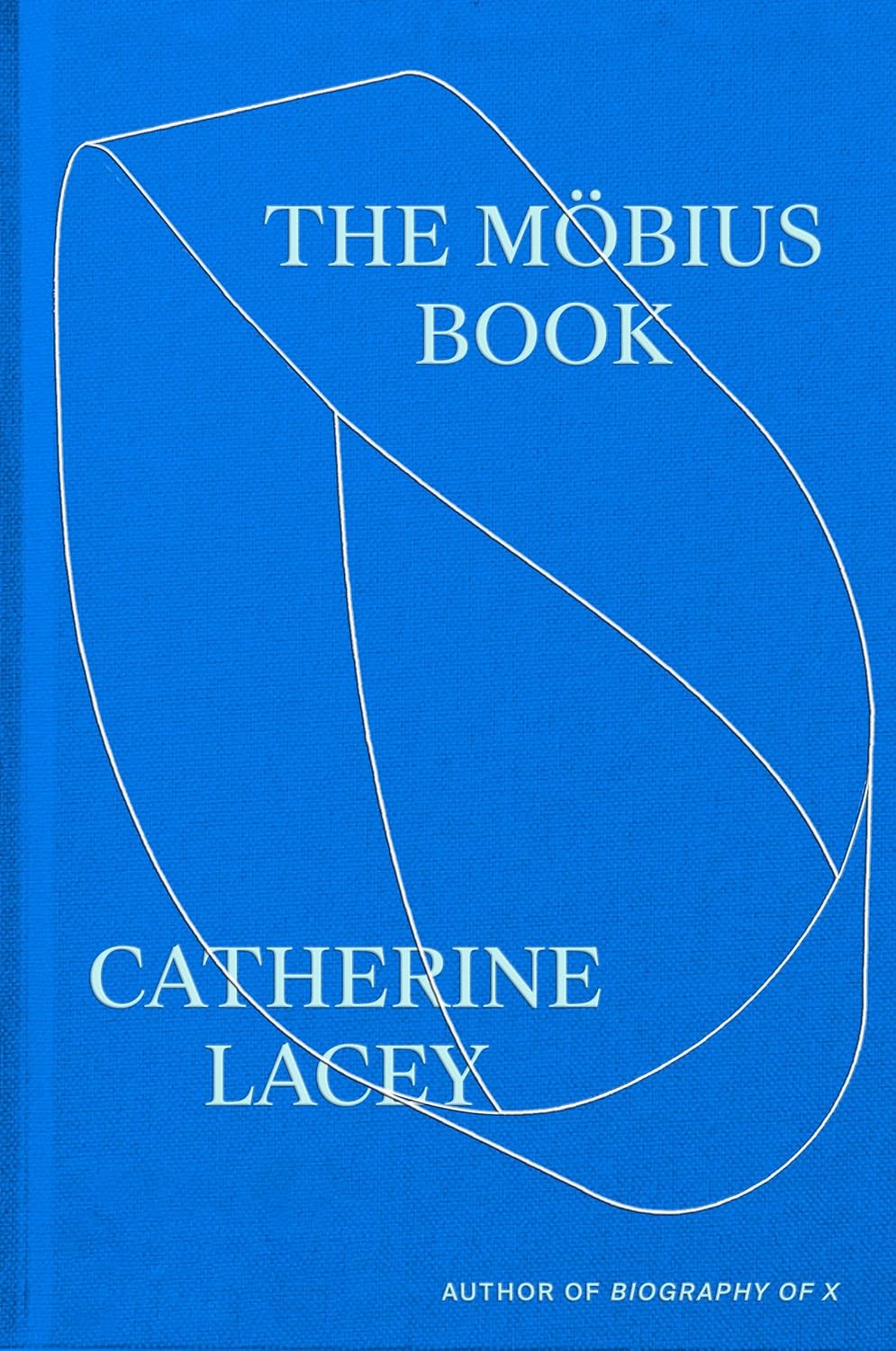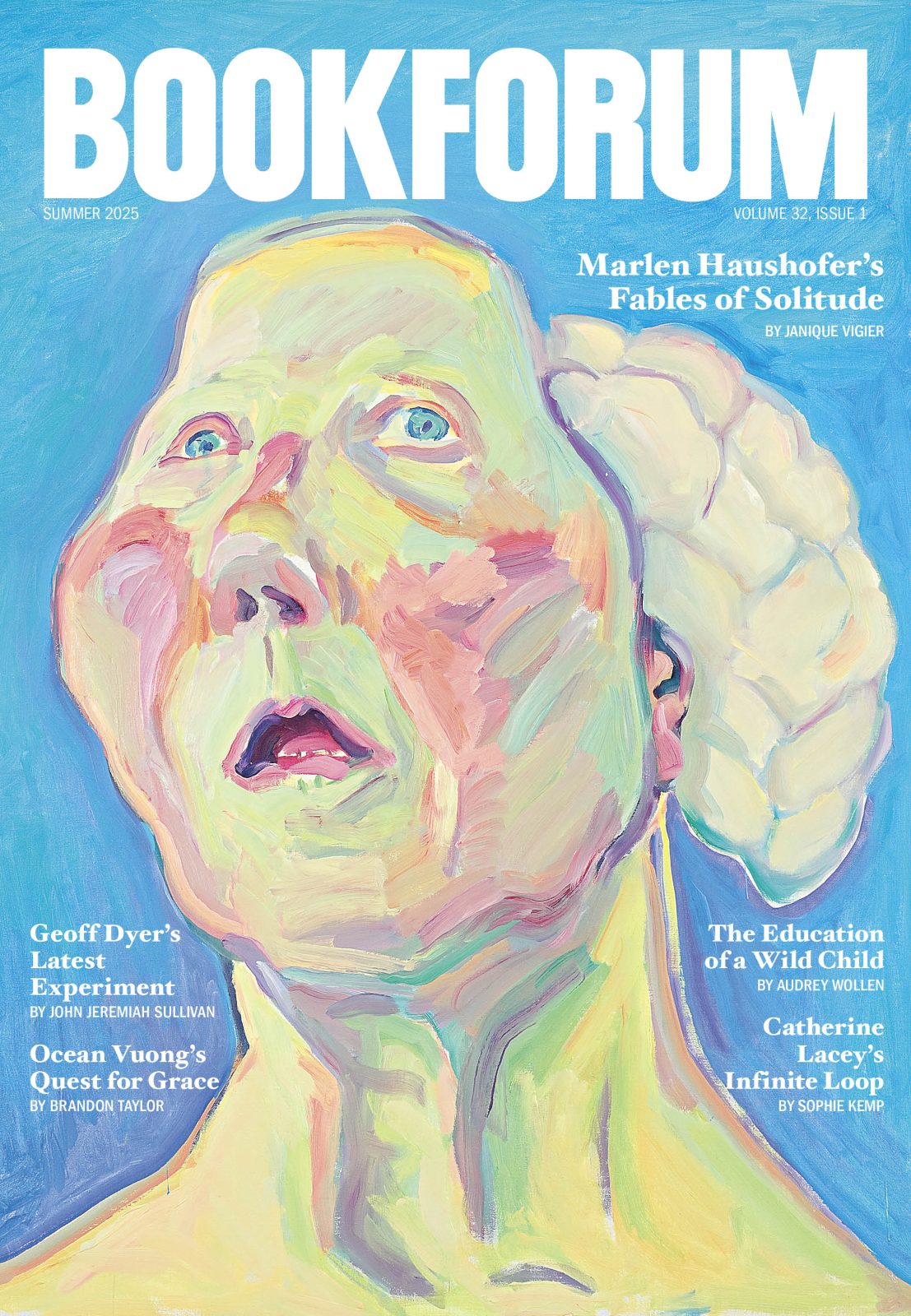
THE NIGHT AFTER I finished reading The Möbius Book, I woke up from a terrible dream. In this dream I had been shrunk back to twenty-three years old, back to a uniquely terrible relationship with a man. He began to argue with me, this man, on account of the fact that he no longer enjoyed my company. I can no longer remember the details of it. I had not dreamed about this man in, I think, a year. I spent the whole day thinking about it afterward: Why now? When I was so happy and newly in love? And then it started to swirl together in my mind. It was the book. The book that I had been so dismissive of while I was reading it. This nightmare from my past was because of The Möbius Book.
A MÖBIUS STRIP is a non-orientable surface. If you were to hold it up in your hands and twist it around, it would look the same when rotated clockwise and counterclockwise. It is also a quantum loop. Time ad infinitum. For Catherine Lacey, in her sixth book and first hybrid work of fiction and nonfiction, the möbius strip is “a set of prompts that resisted completion.” It is a book that, like Julio Cortázar’s Hopscotch, is not just a book but also a puzzle. It is written in two discrete, seemingly unrelated sections. If you read the book in one direction, it is a noir-ish novella about two women, their terrible relationships, and a murder. If you flip it over, the back cover turns out to be the front cover, and the book you read in this direction is a memoir. It tells the story of a woman falling in love with a man with a powerful aura. A man who is referred to as The Reason. He is infinitely cruel and infinitely magnetic. He will break up with her over email after years of dating and living together. He is someone you meet at a party, and you look at him and you talk to him and you think: this person is going to break my heart, this person is going to fuck me up. And then you think: let’s have some fun.
Fun is not exactly a word I would use to describe reading either Part 1 or Part 2 of The Möbius Book. It is a tedious work of prose. It is—and this is the point—barely even a book. It does not follow clear narrative logic. In the memoir portion, it reads almost like a diary. A diary that centers around a prompt it can’t help but circle back on, again and again: How do you intellectualize and dissect a truly terrible relationship? How do you make sense of a bad thing that has happened to you? How do you explain why you fell for The Reason in the first place? Lacey writes about all of this like she is a particle accelerator, like her thoughts are moving faster than she can type. One moment we are in the Deep South of the 1960s, dissecting the divorce of her grandparents: “The divorce paperwork had stipulated that neither she nor my grandfather was permitted to entertain any suitors or remarry, else they’d lose all custody of the children.” Lacey then recounts that her grandmother, in her old age, developed near-total amnesia of the divorce, “painful memories that have nothing else to teach you.” A page later, she is discussing memory and how it makes you, paradoxically, forget: “A youth pastor told me once that when you repented for your sins, Jesus not only forgave you, he immediately forgot what you’d done.”
The thoughts, the images, pile up. In lieu of a narrative, The Möbius Book is more like an ideology. It announces itself as a Great Conceptual Work. Not just about a breakup but about everything.Religious ferocity. Spiritual and physical anorexia, exactly like in Gravity and Grace. Being tied up by your friends. Angel Numbers. “The Yoga Industrial Complex.” Looking at Matisse’s The Red Studio and wondering: Was Matisse the original influencer? Marina Abramović and Ulay “standing in the center of the gallery with their mouths locked together and their noses plugged shut.” Dissociation. “Having sex as much as reasonably possible,” and how this feels like a way “to die and not die.” The novel is baggy and vast. But everything loops back on a central image, deployed and repeated almost at random: Lacey, sitting at her computer, opening up the email from her boyfriend telling her that he is convinced she does not love him anymore. Therefore, he has to leave her. The email becomes a ghost. The email is like Charon, Ferryman of Hades, waving us onto his boat.
Edie and Marie, the heroines of Lacey’s novella, are haunted and they are longing. For Marie, she is haunted by and longs for her estranged wife, whom she has cheated on. Edie is longing for a cruel and eccentric man. He is not too different from The Reason. The novella is almost entirely a conversation between the two women. Not just about their crumbling relationships but also about their theories on love. Both of them speak as if they are trapped on their own desert islands, talking to each other through two seashells connected by a wire. When they speak, they talk about Jenny Holzer. They say things like: “After how many gender studies classes?” And: “How stupid am I?” They occasionally think about the murder next door. They mostly just think about themselves. It feels inconsequential in the schema of the book. There to give narrative stability to a project that otherwise has none.

Here is the thing about The Möbius Book: there are no guardrails. The book, to me at least, is the memoir. The novella feels like ephemera. A sort of related fictional work to compare and contrast. This in and of itself isn’t necessarily a problem. A book does not need to be cohesive. It can be disparate. If Lacey has learned anything from Kathy Acker, whom she writes into her novel Biography of X, it is that a book can be the same thing as a painting. A book can be the same thing as a collage! The Möbius Book follows this logic. But where Acker’s experimentalism feels generative, Lacey’s sometimes feels gimmicky, hinging on the fact that you can literally flip the book over and have it be a different book.
As a result, the book is uninterested in giving us security by way of form. It’s an interesting project, to rebel against narrative in this way. To write in almost a complete stream of consciousness. And there is precedent for this. Novels have experimented with form for as long as there have been novels. A recent example is Lucy Ives’s Life Is Everywhere. This novel follows a similar premise: woman and man are happily married. Or so woman thinks. Woman finds out husband is cheating on her. What ensues is something that can barely be called a novel at all. Instead it is about, among other things, the history of Botox, a biography of a fake academic, two “unpublished” novellas, and a ConEd bill. The breakup lurks throughout all of this.
Shortly after Ives published Life Is Everywhere, she wrote an essay for The Baffler called “The Weak Novel.” This essay is basically a theory of Ives’s own novel. But it is also a theory that can be applied to many, many books. The conceit is this: “The weak novel is frequently non-narrative and/or seemingly incomplete. It does not avoid digression and possibly exhibits eccentric scrapbooking, grab-bag tendencies that call upon the reader to help the writer out in a struggle to marshal the book’s very material (i.e., to finish writing it).” The Möbius Book, both its novella and its memoir, easily fit into this description. They are definitionally incomplete works. Lacey’s novella has more of a concrete narrative, but it does not have a concrete ending. Lacey’s memoir has neither a beginning nor an end, and its narrative logic is not having a logic. The design of the book makes it so when you finish either novella or memoir you are in the middle of the book. A perfect nod to the möbius strip. As Lacey writes “we were looking for endings, but all we could find was more middle.” Pain, exquisite love pain, often has no beginning, and often has no end.
All of this is rich territory for a conceptual prose work. I am a big believer and a full-throated defender of prose that is interested in being weird and difficult and fractal and scary over legibility. But the thing about conceptual works of prose is they almost never work if they do not make us laugh. It needs to acknowledge life’s inherent absurdity especially when it takes on trauma. This is one of the amazing things about Life Is Everywhere. It is really, really funny. It acknowledges that self-awareness needs to be undercut with some sort of sense of humor and a sense of play. Its playfulness provides us a guardrail, a form when form is lacking. And this is the problem with The Möbius Book. It is so preoccupied with its conceptual project that it forgets to be funny. It is a humorless, completely self-serious book. It lacks the sense of playfulness that experimental prose demands in order to be legible. At its worst, it panders to us. I’m again drawn to the Jenny Holzer comment in the novella. We can’t be saved even if we know about Truisms. What a radical idea: that you can be smart as a woman and fall for the trap that is men. Rejoice! Our times are intolerable, babe.
This is what is the most difficult thing about The Möbius Book. Not the formal inventiveness (which, again, is essentially “not having a form”), but the fact that it is exhausting to read. It is full of aphorisms and the name-checking of Impressive Books and Impressive Works of Art. Not just Jenny Holzer. Take this example from the middle of the memoir: “In line at the airport, I was angry at Seneca,” goes one of the many precocious lines in the book. “Fine. OK Fuck you, Seneca,” she writes on the next page. In this section, Seneca is name-checked to contextualize “the stubbornness of female grief,” because Seneca believed widows should be permitted to mourn their husbands for ten months maximum. Because too much more than that means you will just allow yourself to personally lapse into sadness. That’s all fine and dandy, but I couldn’t help but feel like these references, and there are hundreds of them, exist to pad Lacey’s prose. To dazzle us without actually doing so. They take away from the book’s brutal emotional reality.
And this is what is actually dazzling about The Möbius Book,the moments when it does not speak in generalities about suffering and instead opts to be plain and specific. There’s one moment in particular, in the memoir, about halfway through. It is a description of fighting. How when they would argue, The Reason would slap himself in the face. He would do it two, three times. He did it as if to say: look at me, I have the self-control not to hit you. Within a year, Lacey would do it, too. She would hit herself in the face. The Reason, realizing what she was doing, asked her to stop. She didn’t. He didn’t, either. The Möbius Book is at its best when Lacey dutifully transcribes these banal horrors. These are the moments I found the most truly heartbreaking. When the book stops trying to hurl its big ideas at us and instead truly functions as a diary, a record of the messy thoughts a woman has after she is heartbroken at the hands of her abuser.
“Fiction,” Lacey writes toward the end of the memoir, “is a record of what has never happened and yet absolutely happened.” This is how I felt when I woke up from my dream, the day after I finished The Möbius Book. What I dreamed was not real. I had not been Lewis Carrolled down to twenty-three years old. But I can—if you’ll stick with me for a moment—still look beyond the looking glass and access all the feelings I once had, so long ago. I can remember what it was like to be twenty-three and terrified and confused and “able to provoke huge, disproportionate emotions without warning,” as Lacey writes. This is what has stuck with me about The Möbius Book,the book’s ability to both brilliantly transcribe and conceal what has actually happened. To ultimately be grounded in a powerful emotional reality. The best moments of The Möbius Book go like this: we’re back to the flickering image of Lacey in front of her computer, checking her email, unaware, waiting.
Sophie Kemp is the author of Paradise Logic (Simon and Schuster, 2025).
